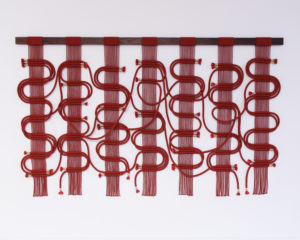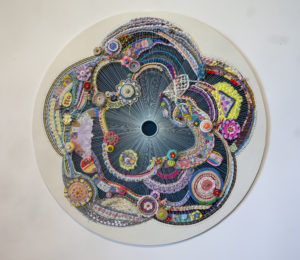
Meet the artists featured in the exhibition, A Beautiful Mess: Weavers and Knotters of the Vanguard, organized by the Bedford Gallery at the Lesher Center for the Arts in Walnut Creek, CA. This week we will highlight four of the artists on display. These artists push the boundaries of fiber art, infusing their works with personal stories and socio-political concerns to further revolutionize the previously marginalized artistic genre.
Windy Chien
San Francisco, CA

Windy Chien, Circuit Board, 2021, rope, vintage 24k gold Japanese thread, synthetic Chainette yarn, 58 x 96 x 2.5 in.
Artist Windy Chien is best known for her 2016 work, The Year of Knots, in which she learned a new knot every day for a year. Her work ranges in size from a knot that can fit in the palm of a child’s hand to room-sized installations that are sought after by private collectors. Following long careers at Apple and as owner of legendary music shop Aquarius Records, she launched her studio in 2015. Select clients include the National Geographic Society, the De Young Museum, Nobu Hotels, Google, and the Kering Group, and her work has been covered by Wired, The New York Times and Martha Stewart.
Artist Statement
I make sculpture and site-specific installations that elevate the vernacular forms of knots to inspire awe and understanding. To the intersection of function, mathematics, and history where knots reside, I introduce aesthetics to illuminate what’s most fascinating about them: the journey of the line.
Knots are artifacts of human ingenuity: an ancient technology predating the wheel and use of fire. Knots manifest tension, direction of pull, forces working in harmony and in opposition. Examining these empirical aspects, I consider their physical function, cultural significance, and aesthetic value. I gave myself an assignment to learn a new knot —out of the almost 4,000 documented— every day for one year, creating The Year of Knots (2016). As I sought fluency, I came to recognize knotting as a universal language spoken across oceans, centuries, genders, and occupations.
Drawing from The Year of Knots as my ongoing palette, each of my ensuing bodies of work explores a single, exquisite knot in search of its ultimate expressive potential. The finished works are minimalist rope sculptures that utilize pattern, repetition, and monumental scale to emphasize the poetry of the line. Increasingly, I seek unusual materials to incorporate provenance and metaphor, such as frayed, soiled climbing ropes, decommissioned fire hoses, and seat belt webbing. I use composition and technique to explore the tension between assumed ideas, such as in my Circuit Boards series, which contrast male-dominated tech world motifs via gendered skills of so-called “women’s work”—the crafts of macrame, passementerie, weaving.
My practice melds art with craft, aesthetic with function. While the output is often beautiful, this quality is intended to draw the viewer in and provoke awareness of the concepts behind the visual harmony: a deeper clarity of looking.
Kirsten Hassenfeld
Brooklyn, NY

Kirsten Hassenfeld, Flower for an Hour, 2021, salvaged textiles with mixed media, 54 x 1.25 in.
Kirsten Hassenfeld moved to New York in 1999 and has been living and working in Brooklyn ever since. She focused on making sculptural works from paper until 2012, when recycled materials and objects became her primary medium. Originally a printmaker, she most recently has turned her attention to large-scale woven wall works. Hassenfeld weaves her salvaged fabrics into vividly hued arrangements that are densely packed with pattern. By using scraps from blankets, wedding dresses, and tablecloths once owned by strangers, the artist reveals the mysterious stories tucked away in them. She is continually inspired by the work of people who used the materials they had on hand to make utilitarian and beautiful objects, and people of today who repurpose what others might through away into wholly new creations.
Material and form play a large part in Kirsten Hassenfeld’s sculpture. For Flower for an Hour, she used a radial form with the weaving emanating from the center point of the piece. The shape, an homage to the flower, is the basis for the artist’s expression, and speaks about the history of design and handicrafts, our relationships to the natural world, as well as the experiences of being female.
Dana Hemenway
San Francisco, CA

Dana Hemenway, Untitled (extension cords – green), 2013, 42 extension cords, fluorescent light fixtures, wood, mixed media, 120 x 60 x 28 inc. Courtesy of Eleanor Harwood Gallery, San Francisco, CA
Dana Hemenway is an artist, curator, and educator based in San Francisco. She received her MFA from Mills College and her BA from University of California Santa Cruz. Her work is rooted in the excavation and elevation of utilitarian objects to make visible what has become habituated in our built environments. Hemenway uses these functional items as materials to form traditionally fiber-based crafts—lights and cords are woven through ceramics or the gallery wall, extension cords are transformed into macramé chains. Hemenway has had residencies at the Bemis Center for Contemporary Art (Omaha, NE), ACRE (Stueben, WI), SÍM (Reykjavik, Iceland), and The Wassaic Project (Upstate New York). Dana is the recipient of The San Francisco Arts Commission Individual Artist Grant and a Southern Exposure Alternative Exposure Grant. She just completed a public art commission for SFO’s Terminal 1, which opened in May of 2020. Dana has exhibited her artwork locally, nationally, and internationally. From 2015 to 2017, Dana served as a co-director of Royal Nonesuch Gallery, an artist-run project space in Oakland, CA.
Kira Dominguez Hultgren
Bay Area, CA

Kira Dominguez Hultgren, Across_1, 2018, handspun and industrially spun wool, acrylic, cotton, metallic thread, novelty yarn, rayon, wool rug mill ends, roving, polyurethane tape, coaxial cables, plastic tubing, nonmetallic conduit, stranded copper wire, digital-hand loomed jacquard fabric, wood and plastic loom bars and posts, nylon rope, zip ties, 96 x 212 x 10 inches. Courtesy of Eleanor Harwood Gallery, San Francisco, CA. Image courtesy of Shaun Roberts.
Kira Dominguez Hultgren is a U.S.-based artist and educator. She studied French postcolonial theory and literature at Princeton University, and performance and fine arts in Río Negro, Argentina. With a dual-degree MFA/MA in Fine Arts and Visual and Critical Studies from California College of the Arts, her research interests include material and embodied rhetorics, re-storying material culture, and weaving as a performative critique of the visual. Dominguez Hultgren has exhibited her work at the de Young Museum, headlined Untitled, ART SF, was featured in Architectural Digest, and has been reviewed in the New York Times. She has had two solo shows with Eleanor Harwood Gallery in San Francisco, where she is represented, a solo show at Heroes Gallery in NYC, and her first solo museum show at the San Jose Museum of Quilt and Textile. Her fellowships and residencies include the Headlands Center for the Arts, Facebook, and Gensler Architecture. Dominguez Hultgren is part-time faculty at SAIC in Fiber and Material Studies.
Artist Statement
Chicanx, Punjabi, Hawaiian: weaving is about strange combinations. Teal penetrates magenta. Gold interrupts. Handspun wool twists with glitter, only to get trapped in cotton. As my mother likes to say when she sees a surprising multiracial body: “who invaded that guy?” Materials erase, seduce, replace, choke as they wind their way through a warp, under weft, are put under tension or are set free of it. 3/8 Indian. 1/8 black and white. Authenticity diluted by eighths!
What are you? I am a weaver of ends, of each generational end. I am a promiscuity of culture in rayon and knit caught in the warp of a backstrap loom, picking out the pattern in a Mapuche poncho. But are these my stories to tell?
I am Hollywood Hawaiian. My work is a tribute to my grandmother Lawhaii (Kikume) Johal. That’s Hawaii with an L. She grew up believing her family was native Hawaiian.Her uncle was Chief Mehevi, Chief Rakos, the authenticating bodily presence of the savage and of the exotic in the jungle movies of the 1920s-50s.
What are you? Check the box. Are you human? Type the code. The “Completely Automated Public Turing test to tell Computers and Humans Apart” (CAPTCHA) is the puzzle that compels me to choose as I navigate the web. Prove you’re not a robot. But there are too many seams, too many constructed cultural affiliations sutured together.
This is the performance of the unassimilated without homeland: please check one box only. Mark yourself as Other.

